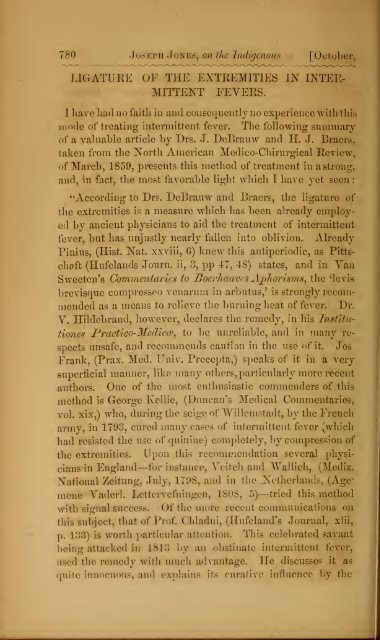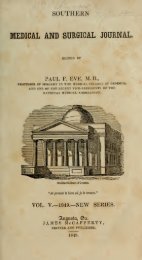Issue 10, pp. 753-832, October 1861, SMSJ
Issue 10, pp. 753-832, October 1861, SMSJ
Issue 10, pp. 753-832, October 1861, SMSJ
You also want an ePaper? Increase the reach of your titles
YUMPU automatically turns print PDFs into web optimized ePapers that Google loves.
780 Joseph Jokes, on (he Indigenous [<strong>October</strong>,LKiATI Ki: OF THE EXTREMITIES IX INTEE-MiFEENT FEVERS.J have had no faith in and consequently no experience with thismode of treating intermittent fever. The following summaryof a valuable article by Drs. J. DeBrauw and II. J. Braers,taken from the North American Medico-Chirurgical Review,of March, 1859, presents this method of treatment in a strong,and, in fact, the most favorable light which I have yet seen :'•According to Drs. DeBrauw and Braers, the ligature ofthe extremities is a measure which has been already employedby ancient physicians to aid the treatment of intermittentlever, but has unjustly nearly fallen into oblivion. AlreadyPinius, (Hist. Nat. xxviii, G) knew this antiperiodic, as Pittsclioft(Hufelands Journ. ii, 3, <strong>pp</strong> 47, 48) states, and in TanSweeten's Commentaries to Boerhaave* Aphorisms, the 'levisbrevisque compresseo venarum in arbutus,' is strongly recommendedas a means to relieve the burning heat of fever. Dr.V. Hildebrand, however, declares the remedy, in his InstitutionesPractico-Medicce, to be unreliable, and in many respectsunsafe, and recommends caution in the use of it.JosFrank, (Prax. Med. TTniv. Precepta,) speaks of it in a verysuperficial manner, like many others, particularly more recentauthors. One of the most enthusiastic commenders of thismethod is George Ecllie, (Duncan's Medical Commentaries,vol. xix,) who, during the seige of Willemstadt, by the Frencharmy, in 1793, cured many cases ofintermittent fever (whichhad resisted the use of quinine) completely, by compression ofthe extremities. Upon this recommendation several physiciansin England—for instance, Veitch and "Wallich, (Mediz..National Zeitung, July, 1798, and in the Netherlands, (Age~mene Yaderl. Lettervefningen, 1808, 5)—tried this methodwith signal success. Of the more recent communications onthis subject, that of Prof. Chladni, (Ilufeland's Journal, xlii,p. 138) is worth particular attention. This celebrated savantbeing attacked il] L813 by an obstinate intermittent fever,used the remedy with much advantage. He discusses it. asquite innocuous, and explains its curative influence by f]\o








